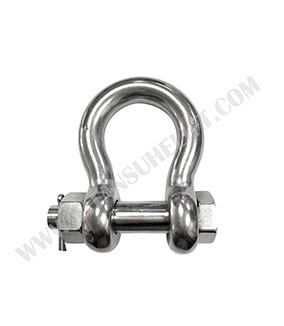Types of Shackles
What is the difference between Anchor Shackles and Chain Shackles
Anchor shackles, in another name bow shackles, is constructed with an "omega" shape that have a larger inner width. It is more used with steel wire rope to make 1 leg or multi-leg wire rope slings. Anchor shackles can be side loaded, but the capacity will relevantly reduce according to the different angles applied.
Chain Shackles, in another name Dee shackle, is constructed with a "U" shape that have a narrow inner space. It is more used with lifting chains to make 1 leg or multi-leg chain slings. Chain shackles are prohibited to side loaded because the side load may twist or bend the shackle body.
How to Use Shackles Properly?
Before each use, check the shackles:
If the markings in the body and the pin of the shackle are clear and legible and conform with the relevant Test Certificate.
If the shackles have correct pins for your application
If the shackles have any deformation or worn
If the shackle body and pin have any nicks, cracks, grooves and corrosion.
Do not use a shackle for lifting purpose that have defects found from above checking.
Before lifting, be sure the shackle pin has been safely locked after assembly. For repeated lifting, it is
recommended to use a bolt type shackle with nut and split-pin - the operator must ensure that the split-pin is fitted, to prevent
the nut from unscrewing during use.
Incorrect seating of a pin may be due to a bent pin, damaged threads or misalignment of the holes. Do not use the shackles that have bent pin damaged threads or misalignment of the holes. When you find a pin can not be correctly seated due to above defects, refer the matter to a qualified person
When use a chain shackle (D shackle), be sure the shackle is fitted to the load that the shackle can take the load along its center line to avoid undeue bending stresses which will reduce the shackle capacity.
Do not modify, reshape, or repair a shackle by welding, heating or bending as this will affect the nominal WLL.
Do not heat treat a shackle as this may affect the WLL.
Temperature Affection to Shackle Capacity
If extreme temperature situations are applicable, the following load reductions must be taken into account.
Temperature | New Working Load Limit |
0 - 200 °C | 100% of original Working Load Limit |
200 - 300 °C | 90% of original Working Load Limit |
300 - 400 °C | 75% of original Working Load Limit |
> 400 °C | not allowed |
What is the Application Difference between Screw Pin Shackles and Bolt Pin Shackles
Screw pin shackles are designed for quick and easy connection and disconnection by screw in and screw out the pin through the pin holes. They are convenient for rigging where pick and place is frequently needed. When use a screw pin shackles, the load may cause the screw pin to be rotated, torqued or twisted, you need to tighten the pin before each use and be sure the pin threads are fully engaged. When screw pin shackles are used for side loading, be sure to used reduced capacity according to the angle calculation.
Bolt type shackles are designed with extreme safety. Structured with a bolt, a nut and a cotter pin, when using this type shackles, you can worry free from the pin loosing, it can remain secure even the shackle is subjected to rotation or torque. Bolt type shackles are practical in many rigging applications where the anchor bolt is expected to experience some rotation. The tightening nut and the cotter pin can always seat and secure the load. There is no need to tighten the pin prior to every lift or movement, so bolt type shackles are your ideal choices for semi-permanent or long-term installations, or where the load may slide on the shackle pin causing it to rotate.














































